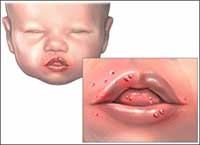
What is Hand, Foot, and Mouth Disease?
Hand, foot, and mouth disease (HFMD), also known as coxsackievirus, is a common illness in infants and children that is caused by a group of viruses called enteroviruses. It is characterized by fever, sores in the mouth, and a rash on the hands and feet. HFMD usually occurs in warmer months and is transmitted primarily between humans by direct contact with secretions from the nose and throat, saliva, fluid from blisters, or the feces of those who have HFMD. 1The time between contact and development of HFMD is about 3 to 7 days.
Hand, Foot, and Mouth Disease

Copyright© Nucleus Medical Media, Inc.
Risk Factors
HFMD can occur in older children and adults, but is most likely to be contracted by:
- Children under 10 years of age.
- Those who have physical contact with the bodily fluids of someone who is infected with HFMD.
Symptoms
Hand, foot, and mouth disease is a common virus that usually starts with a fever, reduced appetite, sore throat, and a general feeling of being unwell. One or two days after the fever starts, painful sores can develop in the mouth. The mouth sores often begin in the back of the mouth as small red spots that may blister or become ulcers. A skin rash with red spots, and sometimes with blisters, also may develop on the palms of the hands and soles of the feet. Sometimes the rash also appears on the knees, elbows, buttocks or genital area.2
Symptoms of HFMD include:
- Mild fever.
- Poor appetite.
- Discomfort.
- Sore throat.
- Painful sores in the mouth, including the inner cheeks, tonsils and tongue.
- Skin rash, usually on the palms of hands, soles of feet, or buttocks, that does not itch and may be painful to the touch.
Some people, especially adults, may show no symptoms at all, but they can still pass the virus to others.
Diagnosis and Treatment
The doctor will ask about symptoms and past medical history. Bodily fluids and waste products may need to be tested to confirm HFMD. This can be done with:
- A throat swab.
- A stool specimen.
Unfortunately, there is no specific treatment for HFMD, and there is no vaccine to prevent it. Treatment is focused on relieving fever, aches, and pain associated with the illness. Medications may be given to help relieve the pain related to the sores in the mouth, though aspirin should never be given to young children. Some people, especially children, may get dehydrated if they are not able to swallow enough liquids because of painful mouth sores. Throat sprays and salt water mouth rinses (1/2 teaspoon of salt to 1 glass of warm water) may help alleviate some of the pain and allow the child to drink more easily. Do not use regular mouthwash because they may sting.
If your child is diagnosed with hand, foot, and mouth disease it is important to notify their school and/or child care provider so that they can inform other parents to be on the lookout for symptoms. HFMD is most contagious during the first week, but can still be passed through bodily fluids for one to three weeks. Recovery from hand, foot, and mouth disease typically takes about 5 to 7 days.3
To lower the risk of contracting HFMD:
- Teach children to wash hands often with soap and water, especially after using a tissue or going to the bathroom.
- Teach children to cover their mouth and nose when sneezing and coughing either with a tissue or into their arm if a tissue is not available.
- Clean and disinfect frequently touched surfaces and soiled items, including toys. Clean contaminated surfaces with soap and water followed by a diluted solution of chlorine-containing bleach. (Mix about one-fourth cup of bleach with one-gallon water.)
- Avoid close contact like kissing, hugging, or sharing eating utensils or cups with people with who have hand, foot, and mouth disease.
When Can a Child Return to School?
A child may return to school except in cases where:
- The child is not feeling well enough to participate in class or has a fever.
- The child has excessive drooling from mouth sores that may be difficult for a teacher or child care provider to manage.
- The child has many open blisters. It usually takes about 7 days for the blisters to dry up.
- The child meets other exclusion criteria.
It is important to note that children can spread the virus even if they have no symptoms and the virus may be present in the stool for weeks after the symptoms are gone, so excluding them from school or child care will not effectively reduce the spread of the illness.
If a child has recovered from HFMD, can they get it again?
Yes, a child can be infected with hand, foot, and mouth disease even if they have had it before.
Sources:
1National Institutes of Health: MedlinePlus
2Centers for Disease Control and Prevention (CDC): Hand, Foot, and Mouth
3American Association of Pediatrics (AAP)
If your child is exhibiting symptoms of hand, foot, and mouth, please consult your physician. Dr. William Thomas, with LewisGale Physicians can help with diagnosis and treatment. To schedule an appointment call the office at (540) 382-6148 or schedule an appointment online.
Book An Appointment Online with Dr. William Thomas